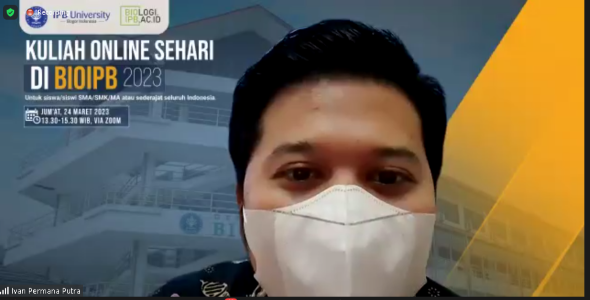Department of Biology IPB University Invites High School Students to Lecture Online One Day About Mushrooms

Hundreds of high school (SMA) students from various regions in Indonesia got short study experience at the Department of Biology, Faculty of Mathematics and Natural Sciences (FMIPA) IPB University. At the One-Day Online Lecture event at BioIPB which took place online (24/3), Dr. Ivan Permana, IPB University lecturer from the Mycology Division of the Department of Biology FMIPA delivered a short lecture related to fungi or fungi.
Dr Ivan said knowledge and data related to fungi or fungi still tend to be low. In fact, fungi are one of the natural resources that are abundant but have not been optimized in Indonesia.
“Wild mushrooms that grow around us, in the forest, in parks, at home have so far received less attention than edible mushrooms on the market. And, don’t think so
also that fungi are plants, even though they are morphologically similar,” he said.
In fact, said Dr Ivan, in evolutionary terms fungi are closer to animals than plants, but they are not animals either. So the assumption that fungi are vegetables is also not quite right.
He explained that the taxonomic or size group of fungi is divided into three, namely yeast or yeast, mold and fungi. Yeasts are microscopic unicellular fungi, while molds are microscopic multicellular. Fungi are macroscopic multicells.
“Fungi or fungi are well known in Indonesia for use by various industries. Starting from the food industry, health to cosmetics. In terms of food, fungi have good nutrition for the health of the body,” he explained.
Dr Ivan said, the growing trend of veganism has also increased consumption of mushrooms. The texture and taste can be processed so that it resembles animal meat.
“From the perspective of researchers or academics, fungi also function as decomposers or degraders of organic matter in nature, as entomopathogens or as endophytes and are symbiotic with plants,” he explained.
He explained, the ability of fungi to help plant growth is also very large. Hyphae from fungi can explore the soil better so they can take water and nutrients for plants to help the process of photosynthesis.
“Fungi can also play a role in the bioenergy industry, so there are many benefits and potentials for functions that we still need to uncover,” he continued.
According to him, students, lecturers and researchers have the task of documenting the diversity of fungi in Indonesia. Moreover, the diversity information has not been recorded properly. “I believe Indonesia’s functional potential is very large, it is necessary to inventory and manage data,” he said.
For example, continued Dr. Ivan, students can take advantage of the research forest around the campus to the IPB University forest laboratory to research fungi. This facility continues to be improved in order to support this target. “Students are also invited to join the mushroom hunter community so they can share knowledge with other mushroom activists from all over Indonesia,” he added.
In addition to receiving lectures on mushrooms, high school students also received information on pathways to enter the IPB University undergraduate program. The paths chosen are quite diverse and provide wider opportunities for prospective students. (MW/Rz) (IAAS/AMR)



















